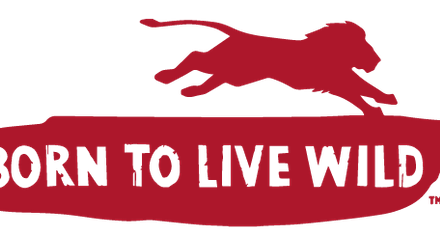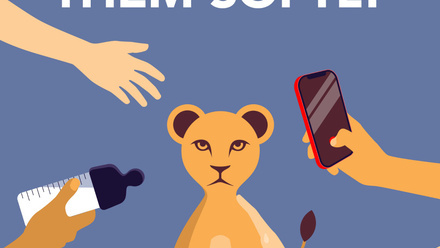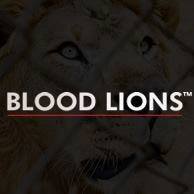-
Primary organisation type
ATTA® for Action
-
Website
Blood Lions film and international awareness campaign expose the exploitation of lions used for interactive tourist activities with captive wildlife, including cub petting, walking with lions and voluntourism. These unethical and insidious practices form part of the life cycle of a lion in the commercial captive predator breeding industry in South Africa that furthermore include the intensive breeding of lions and other predators, "canned" or captive trophy hunting, and the international trade in live lions as well as their parts and derivatives. The Blood Lions story is a compelling call to action to have these practices stopped and the industry closed down.
We encourage all travel agents and tour operating businesses to join the 200+ tourism businesses and sign the Blood Lions Born to Live Wild Pledge. Join us in our endeavours to stop all exploitation of captive wildlife in tourism. Find out more HERE.
Video overview
Where we operate
- South Africa
Where we’re based
- South Africa
News see all news
Document downloads see all downloads
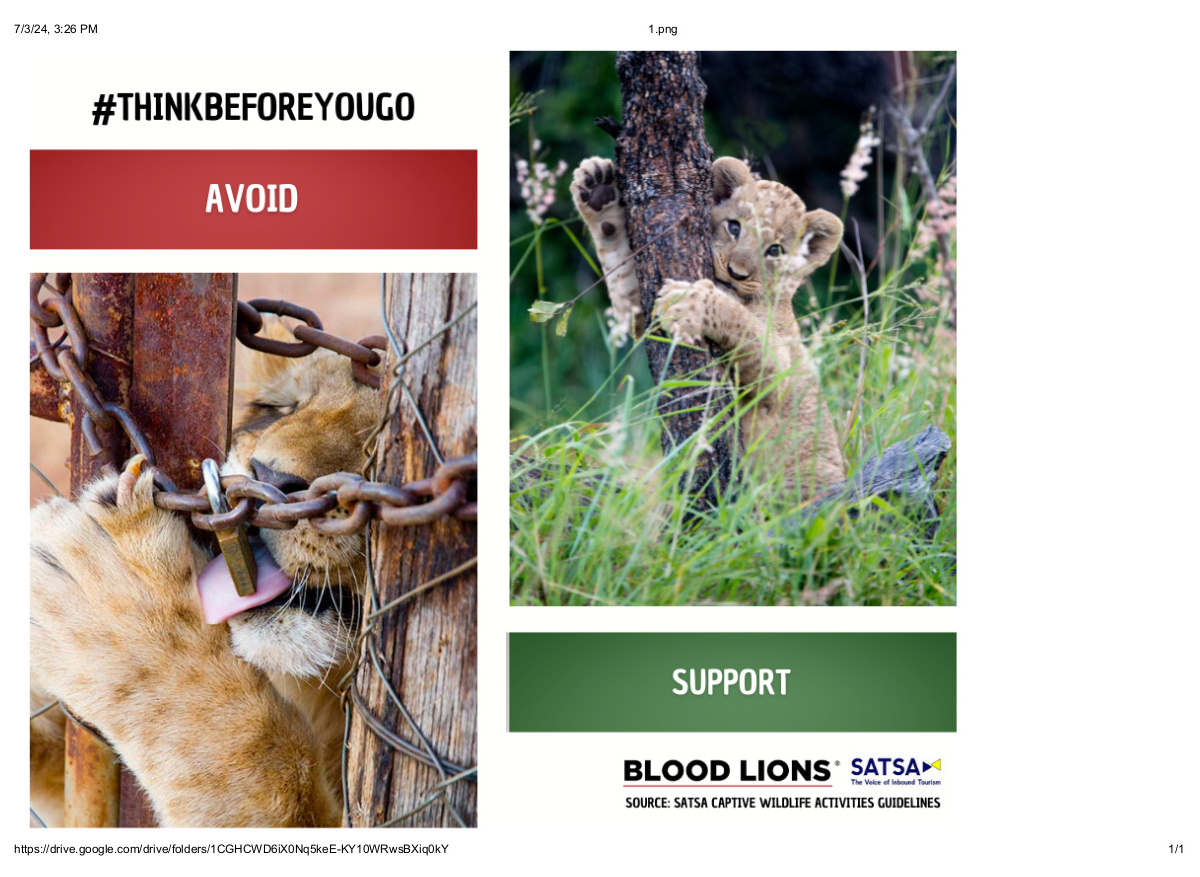
Unpacking the SATSA Guidelines
In 2019, SATSA drew a firm line in the sand concerning captive wildlife attractions in South Africa’s tourism space, which is a dynamic concept based on ethics. They identified activities with captive wildlife to avoid, such as wildlife interactions and circuses, which also included captive breeding of big cats, canned hunting and the trade in animal body parts. Their stance is also aligned with the High-Level Panel sentiments that were recently published in a draft Policy Position paper by the Department of Forestry, Fisheries and the Environment.
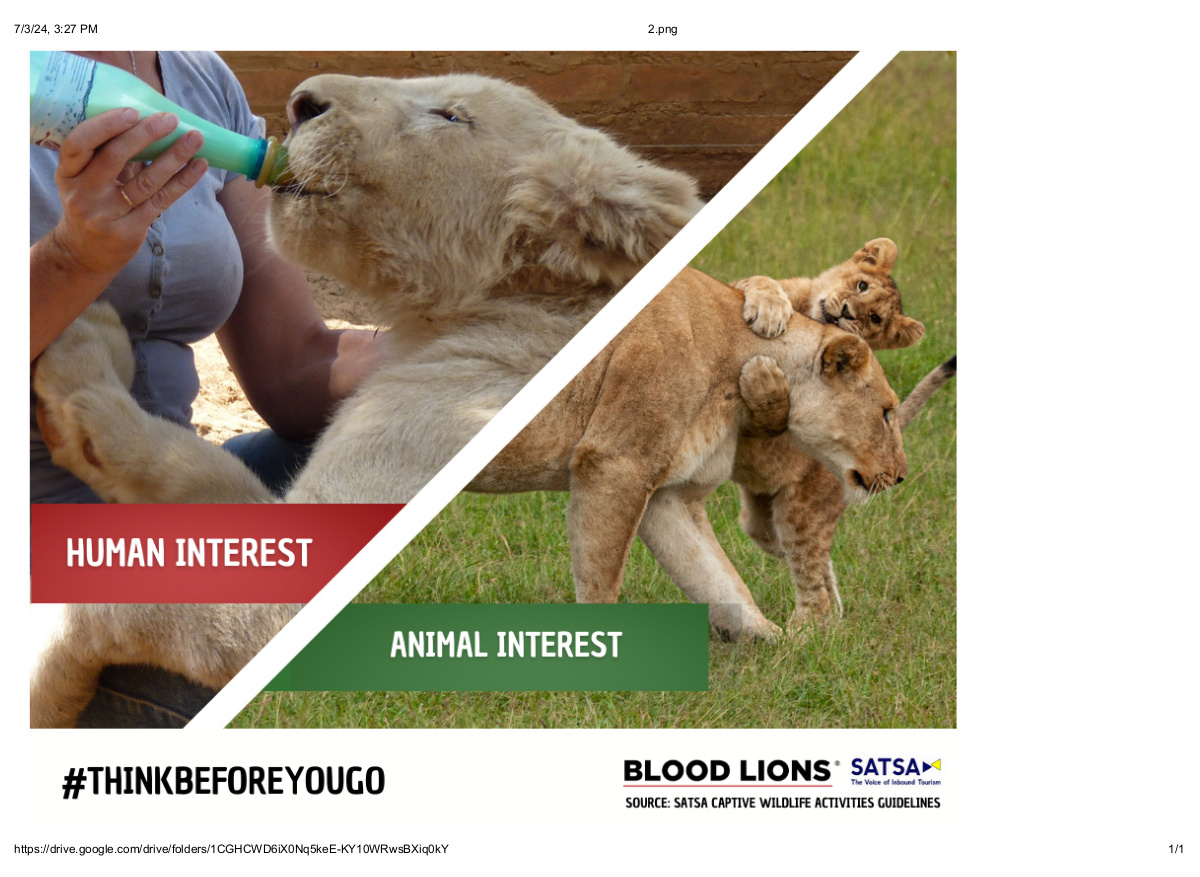
Why were the SATSA Guidelines created?
The SATSA Guidelines and Decision Making Tool were created around an ethical framework with an African approach, which recognises the importance of Ubuntu and the relationship between animals, the environment in which they live, and their connection to humans. The guidelines state that “the interests of animals should not be subordinate to the benefits humans derive from their existence”. Meaning, if a captive wildlife facility clearly prioritises human interest(s) (which can be financial, gratification, entertainment, information) over the animal’s wellbeing, it can immediately be considered unethical. Which captive wildlife tourism activities would you say can immediately be deemed as unethical, and which are in the grey area for you? These are questions that are often not easy to answer and may be different for many of you. SATSA created their guidelines and tool to make these decisions easier and more objective.
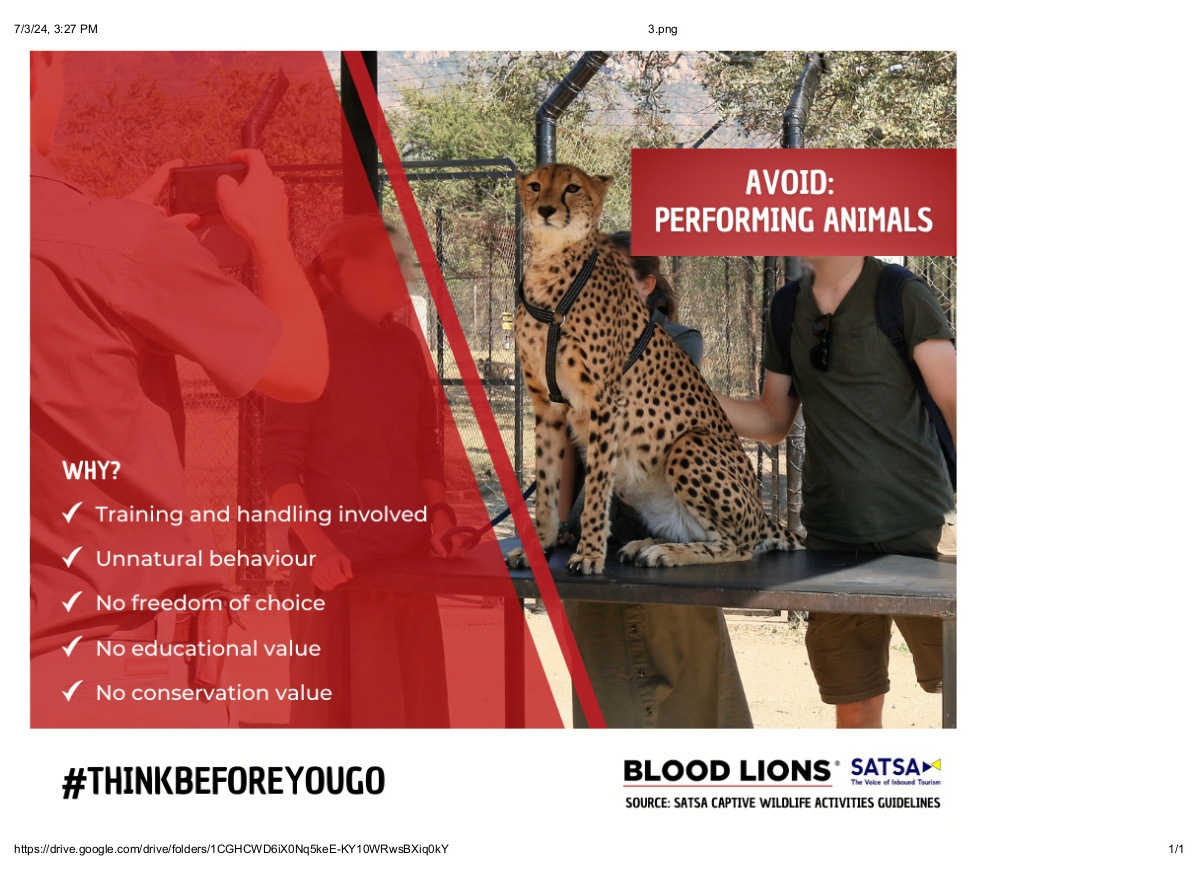
AVOID Performing animals
The first one of five groups of captive wildlife activities to AVOID, as highlighted by the SATSA guidelines, is supporting facilities which keep and/or profit from performing animals. Why avoid activities with performing animals? 1.The animals don’t have freedom of choice 2.There is unnecessary hands-on training and handling involved 3.The animals are forced to exhibit unnatural behaviour 4.It serves no educational value 5.It serves no conservation value. In order to perform in a public show or display, the animal would have undergone some form of training, often involving corporal punishment, tethering and/or food deprivation. Performing animals may include: elephants, predators, primates, cetaceans (aquatic mammals such as dolphins and whales), birds and reptiles.
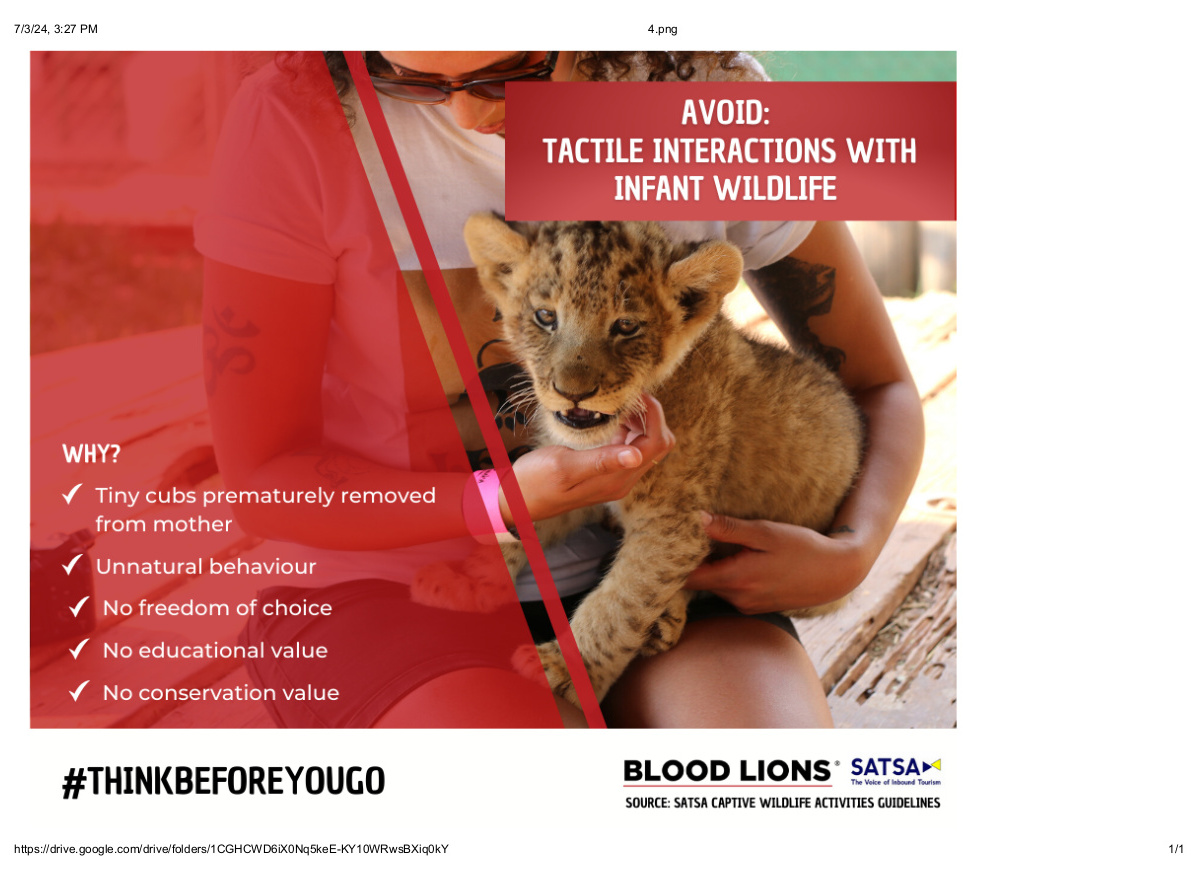
AVOID Tactile interactions with infant wildlife
#ThinkBeforeYouGo: If you are given the opportunity to touch, hold, feed or play with a wild baby animal in captivity in any shape or form, the activity is unethical according to the SATSA guidelines and should be avoided. Why avoid tactile interactions with infant wildlife? 1.Infants are removed from their mothers prematurely 2.The animals don’t have freedom of choice 3.The animals are forced to exhibit unnatural behaviour 4.It serves no educational value 5.It serves no conservation value Removing infant animals from their mothers prematurely is extremely stressful, unnatural for both the mother and the infant, and can lead to long-term health issues. It is not in the animal’s best interest to remove an infant from its mothers for human gratification. Wild animals are naturally fearful of humans and any tactile interaction between a wild infant animal and a human is unethical.
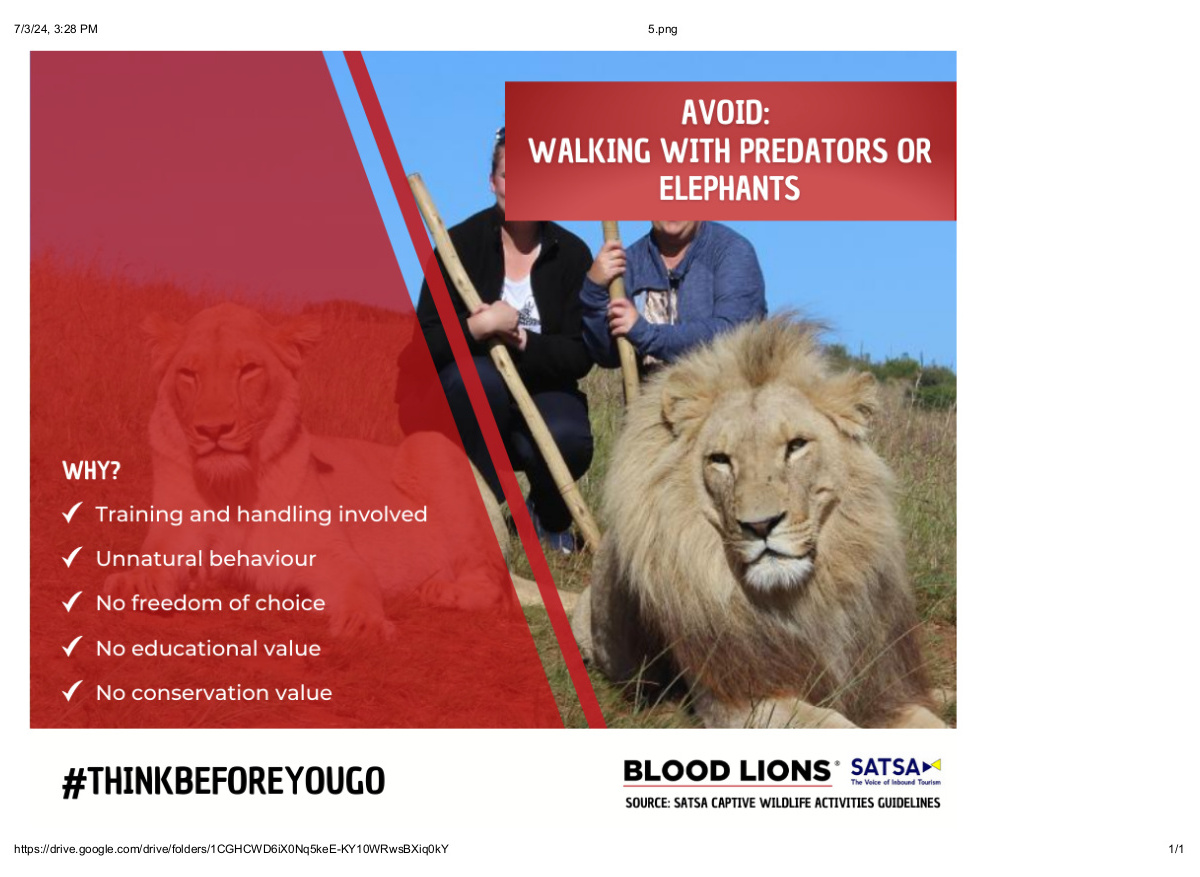
AVOID Walking with predators or elephants
#ThinkBeforeYouGo: The training and handling techniques used to train wild animals to walk alongside humans are frequently harmful to the animals involved. Why avoid walking with predators or elephants? 1.The animals don’t have freedom of choice 2.There is unnecessary hands-on training and handling involved 3.The animals are forced to exhibit unnatural behaviour 4.It serves no educational value 5.It serves no conservation value If you are considering walking with wild animals such as elephants, lions and cheetahs – don’t. It is an unnatural activity for these animals and many are forced to go through intense and often cruel training to learn to behave around paying tourists and volunteers.
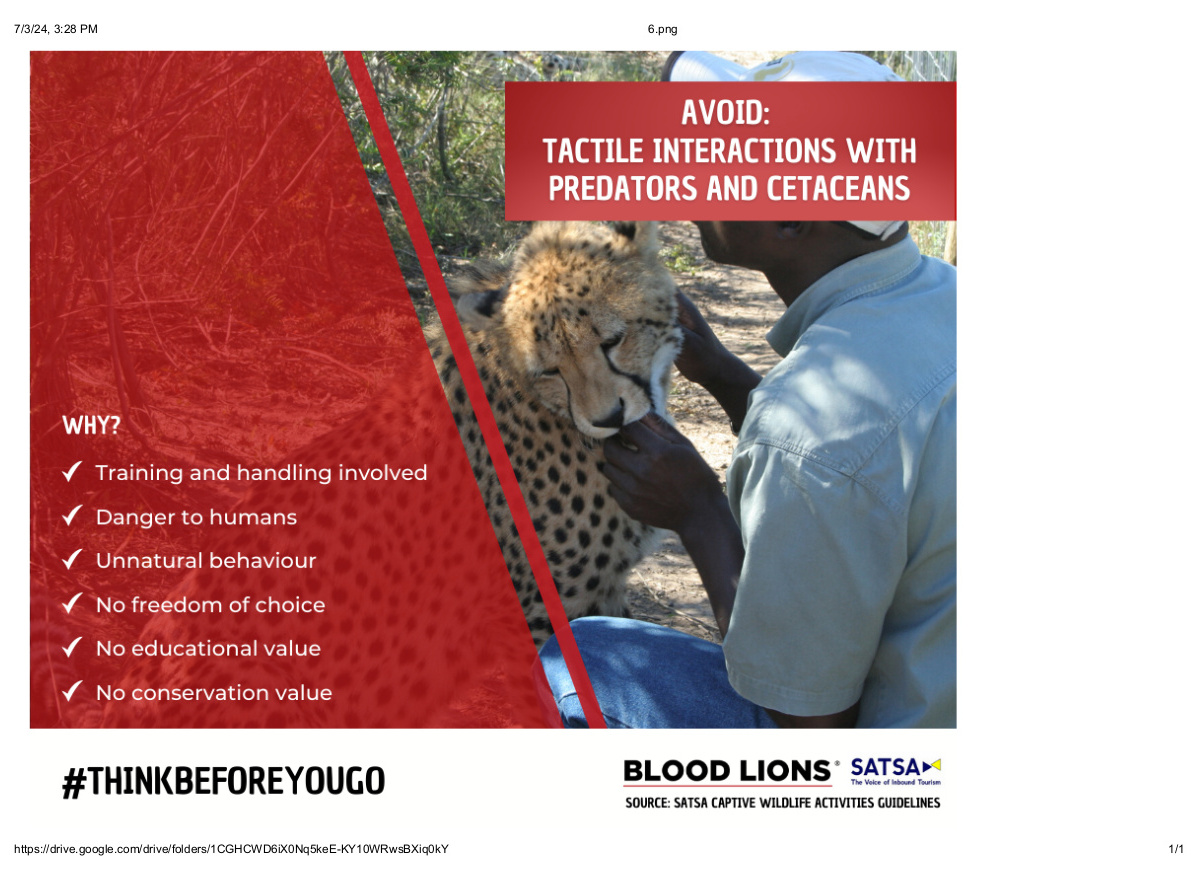
AVOID Tactile interactions with predators and cetaceans
#ThinkBeforeYouGo: Predators are dangerous animals that can inflict serious injury to humans, especially during stressful and unnatural activities that put them in close proximity to humans. Why avoid tactile interactions with predators and cetaceans? 1.It can be dangerous for humans 2.There is unnecessary hands-on training and handling involved 3.The animals don’t have freedom of choice 4.The animals are forced to exhibit unnatural behaviour 5.It serves no educational value 6.It serves no conservation value It is unnatural and unethical for predators and cetaceans to interact with humans and these activities can be extremely stressful for these animals. In addition, the training and handling techniques frequently used can be harmful and indicate that these types of interactions are not in the best interest of the animals.
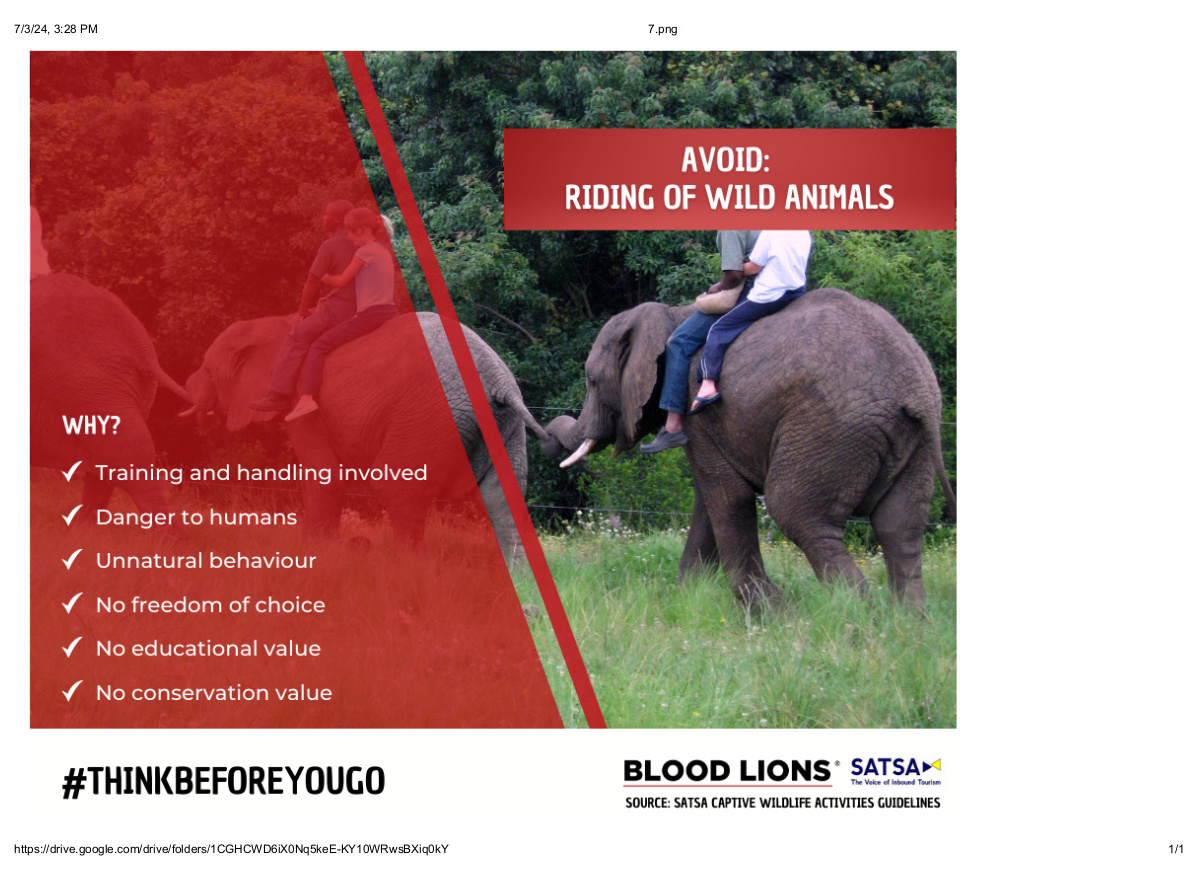
AVOID Riding of wild animals
#ThinkBeforeYouGo: For any wild animal, having a human ride or sit on it’s back, is contrary to their natural behaviour and would not be in the best interests of the animal. Even though elephants, for example, are strong animals, they are not designed to carry weight on their backs, which can cause injury to their spine. Why avoid riding of wild animals? 1.There is unnecessary hands-on training and handling involved 2.The animals don’t have freedom of choice 3.The animals are forced to exhibit unnatural behaviour 4.It serves no educational value 5.It serves no conservation value In many cases the animal would need to be trained to accept humans on their backs. These training techniques frequently involve negative reinforcement and even cruel methods that are often harmful to the animal.
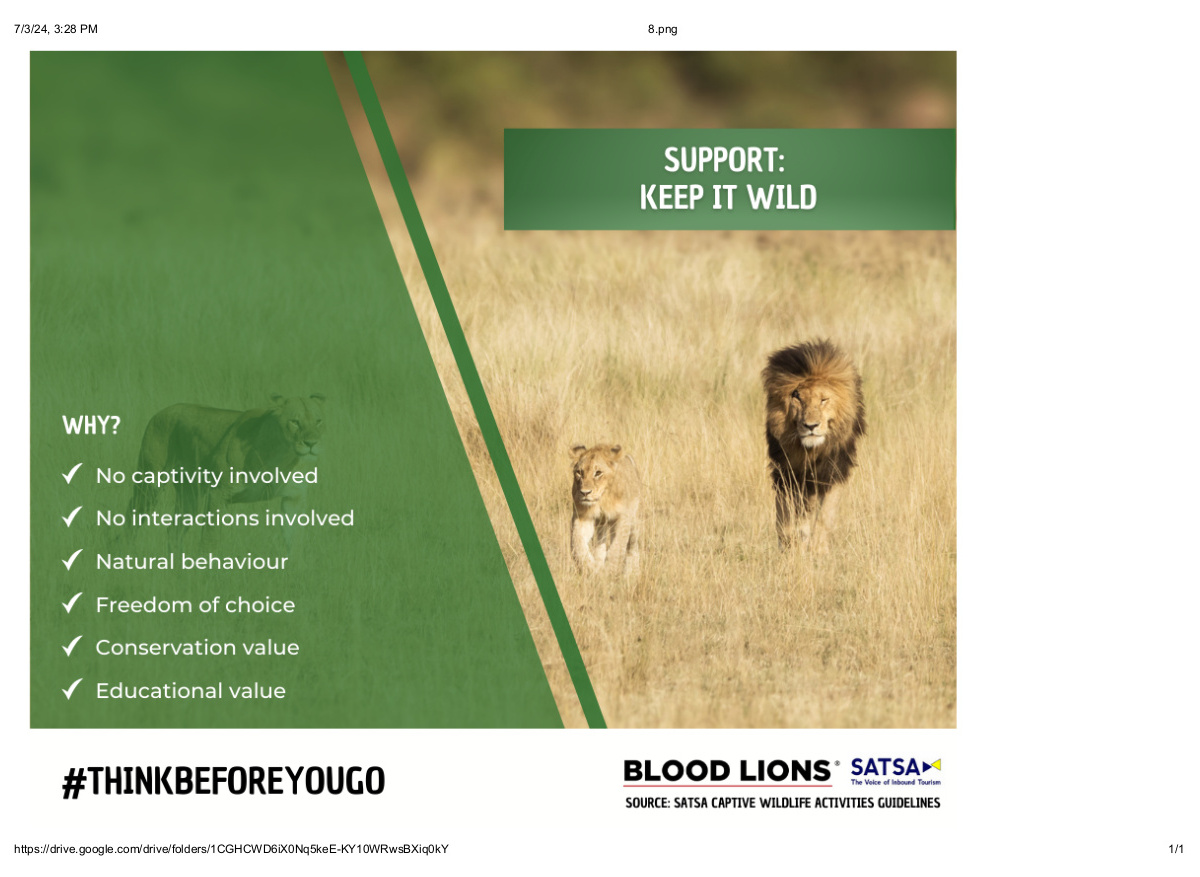
SUPPORT Keeping it wild
The SATSA Decision Making Tool gives people six questions to guide them into making the right decision about whether or not to support a facility that is caring for captive wildlife. The tool interrogates issues such as: 1.Where did the animals come from? 2.What happens to the animals whilst in captivity? 3.What is the likely destiny of the animals? The safest way to ensure your wildlife activity is ethical is to keep it wild. Rather experience lions and other iconic species in their natural habitat by choosing to visit one of the many reserves and national parks that South Africa has to offer.
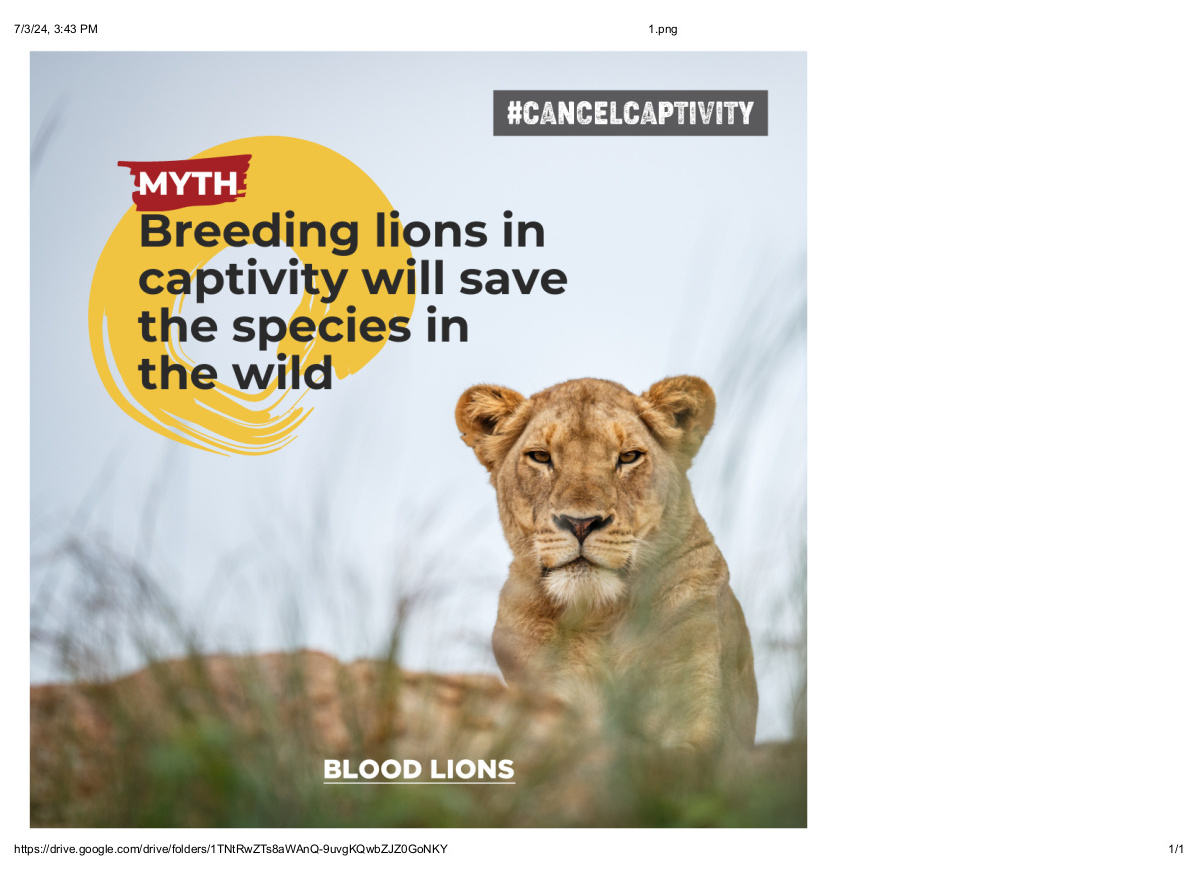
MYTH: Breeding lions in captivity will save the species in the wild
A common myth linked to the captive lion breeding industry is that it has the ability to supplement and save the wild species. This is not the case. The IUCN assessment in 2016 showed that lion populations across the continent had indeed declined by 43% over a 20-year period (or 3 lion generations). The reasons for this decline include habitat degradation and fragmentation, reductions in prey animals, human-lion conflict, and, importantly, the trade in lion products (particularly bones). However, lions breed very successfully in the wild, and lion ecologists agree that we don’t need to spend resources on captive breeding for reintroduction without proven success records. What we need to do is to create more safe space for lions to thrive in functional wild ecosystems. South Africa – it is time to #CancelCaptivity
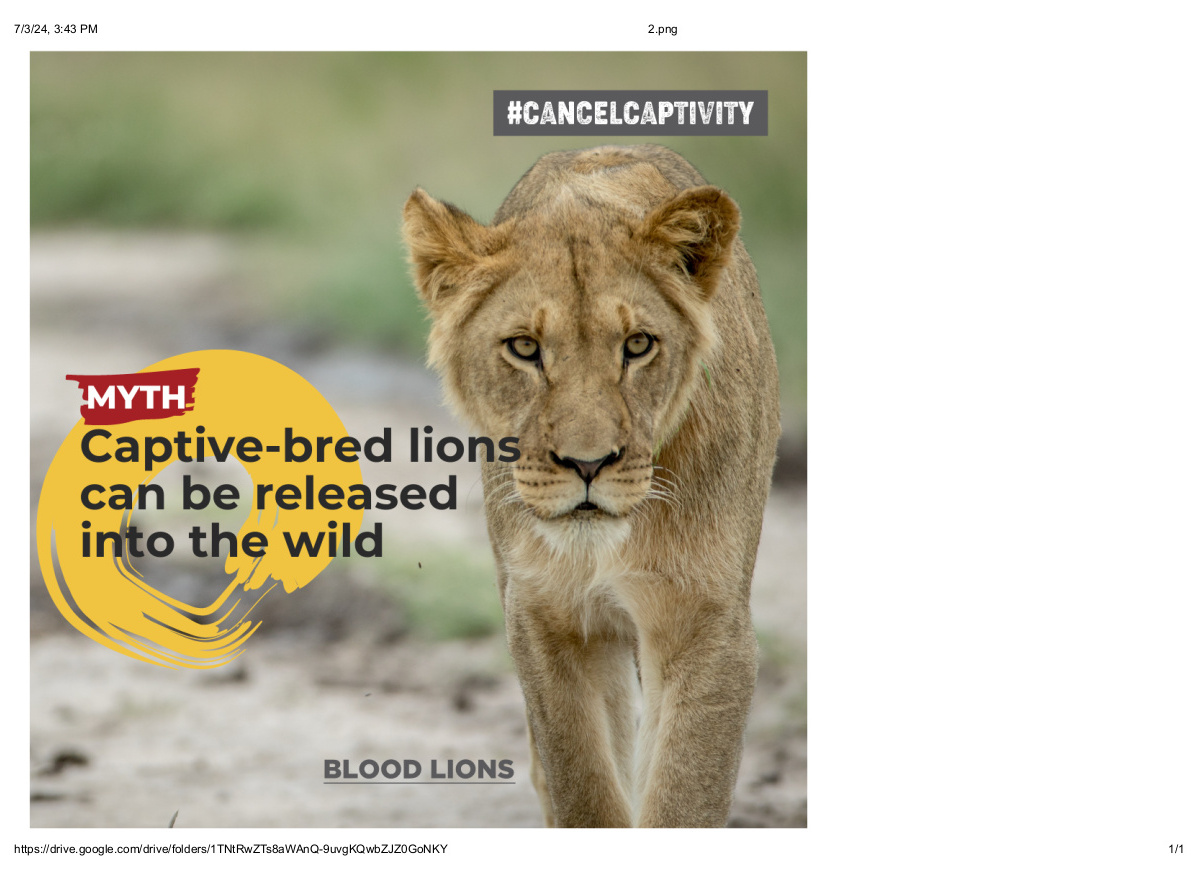
MYTH: Captive-bred lions can be released into the wild
This is one of the most common myths linked to the captive lion breeding industry. As much as a wild animal is never fully tame, captive-bred lions are human-imprinted and therefore lose their fear for humans. This could therefore pose a significant risk for human-wildlife conflict when introduced into wild spaces. This is just one reason why captive-bred lions cannot be released into the wild. South Africa – it is time to #CancelCaptivity
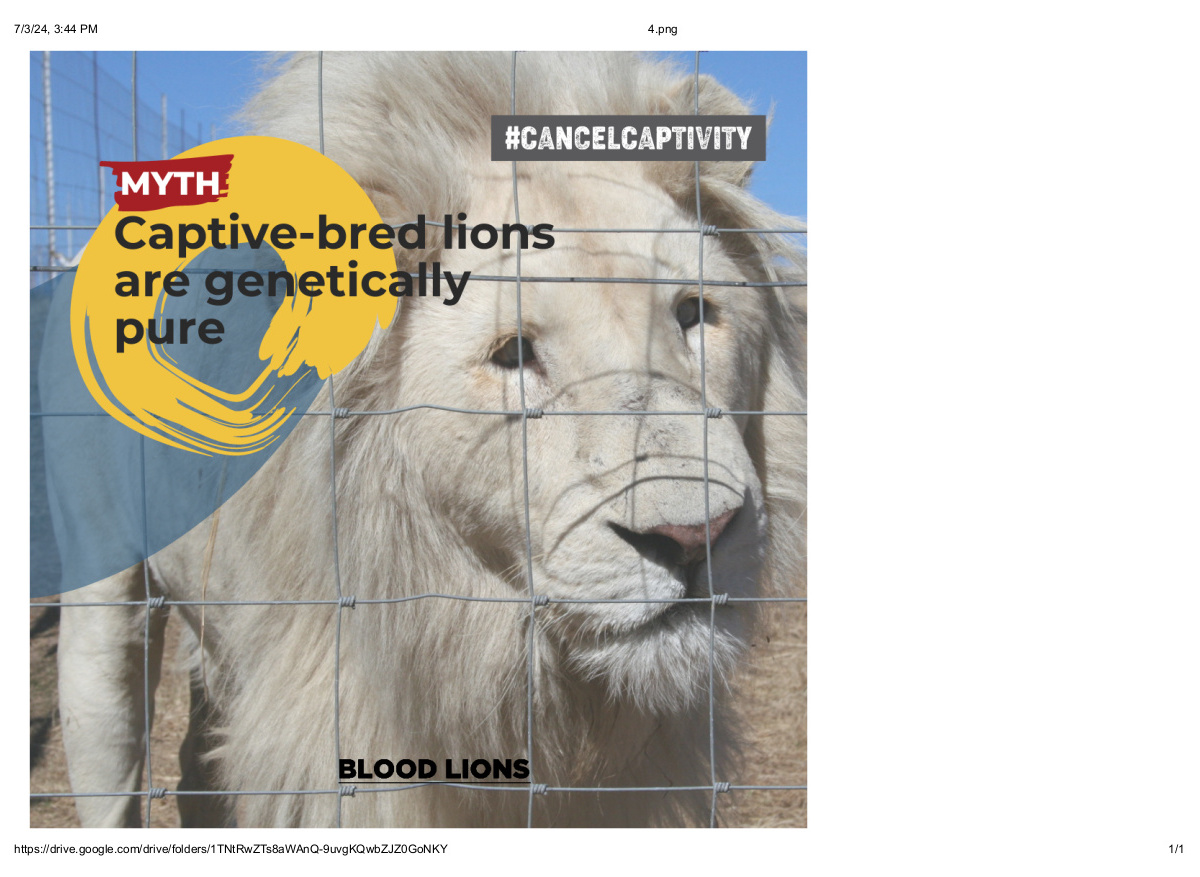
MYTH: Captive-bred lions are genetically pure
The genetics of captive-bred lions are often compromised. The prevailing view amongst carnivore specialists and conservationists is that captive-bred lions do not contribute to the conservation of the species, especially since inbreeding is prevalent in captivity which has a negative effect on genetic integrity and provenance. Lion ecologists agree that releasing compromised genes into a healthy wild population is extremely risky. This is another reason why captive-bred lions cannot be released into the wild. South Africa – it is time to #CancelCaptivity
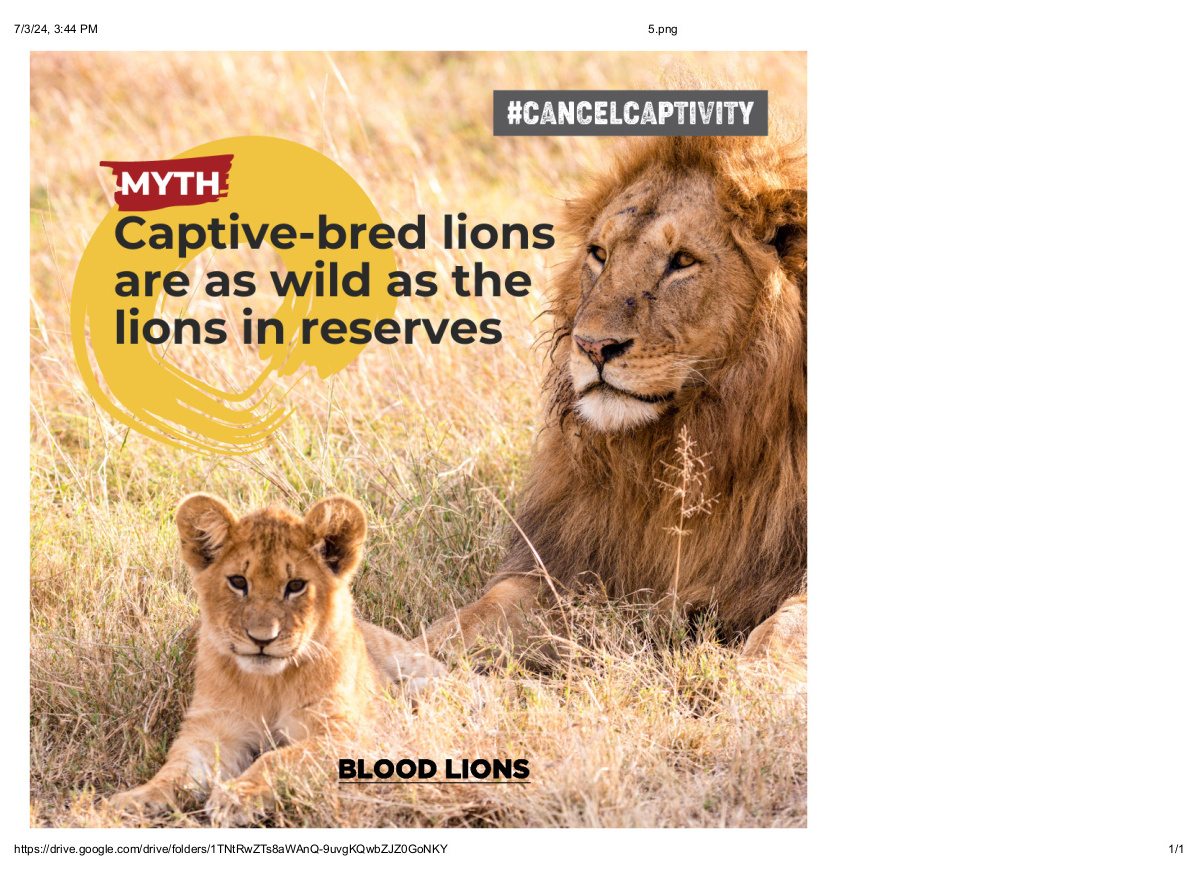
MYTH: Captive bred lions are as wild as the lions in reserves
Although the wild instinct of captive-bred lions may well remain, they are human-habituated animals and are ill-equipped to survive in wild areas. Captive bred lions have never learned to hunt for themselves and/or deal with other predators and dangerous wild animal species. Physically captive-bred lions are also weaker due to a lack of exercise throughout their lives. This is another reason why captive-bred lions cannot be released into the wild. It is time for South Africa to #CancelCaptivity
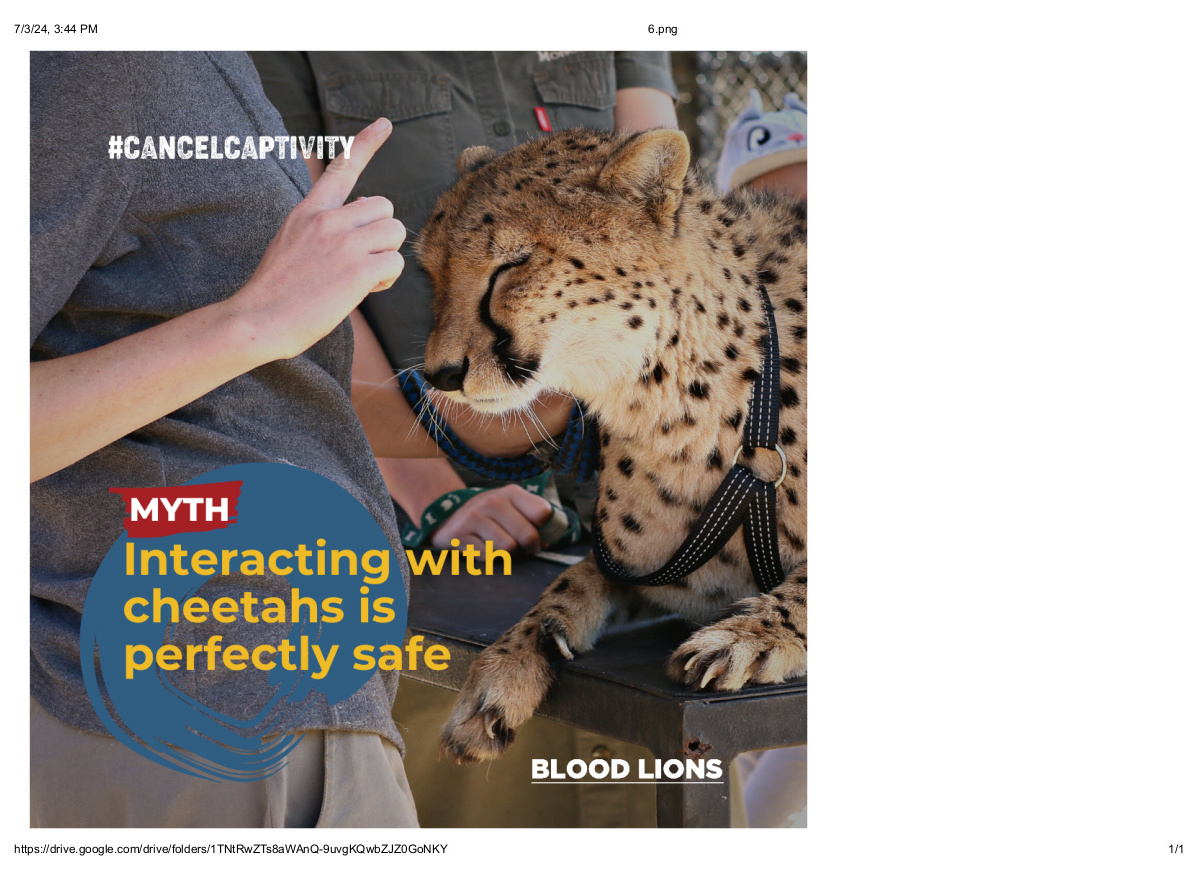
MYTH: Interacting with captive cheetahs is perfectly safe
In the last 15 years, we have recorded 52 incidents of captive cheetahs, lions and tigers attacking a total of 58 people, of which 18 people died as a consequence of the attack. Fourteen of these attacks involved captive cheetahs and one person perished as a result of their injuries. These are just the ones that were reported in the media or on social media… many more attacks likely to go unreported. It is time for South Africa to #CancelCaptivity
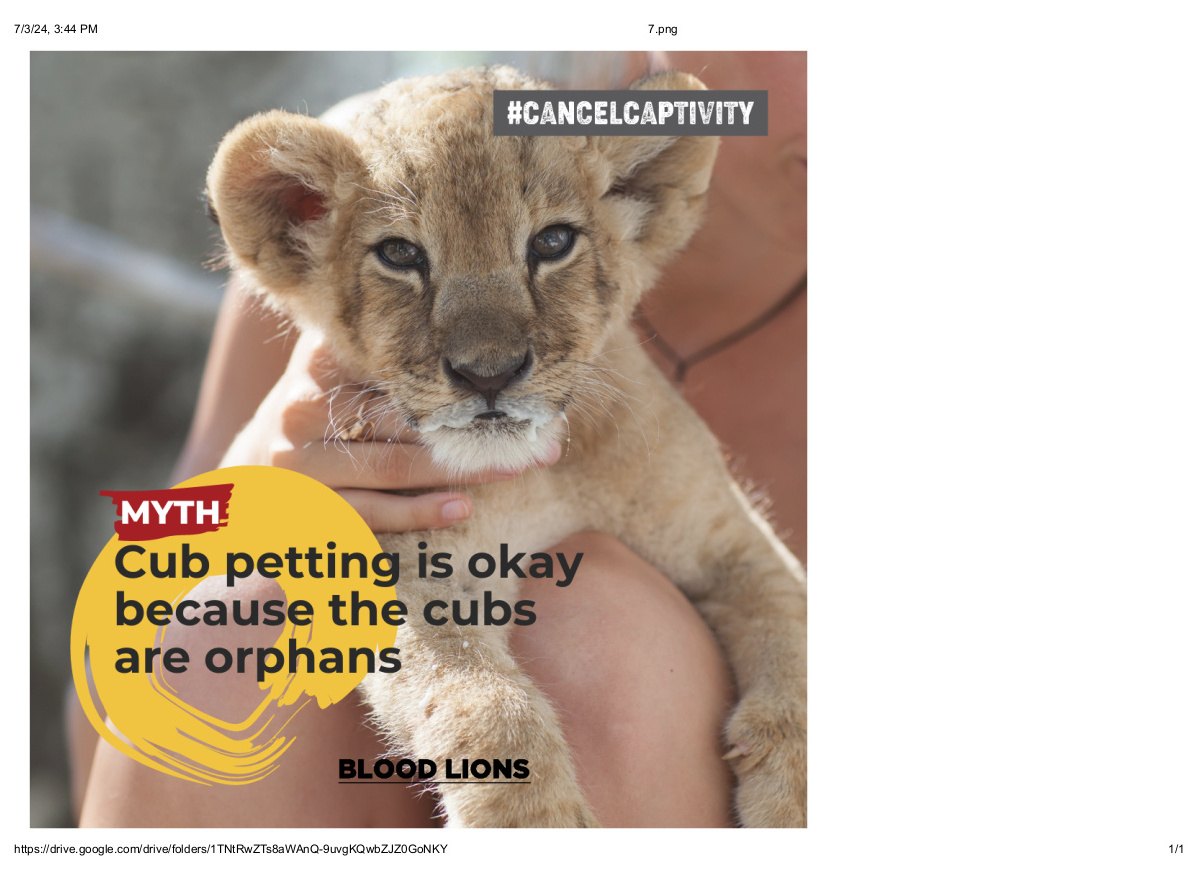
MYTH: Cub petting is okay because the cubs are orphans
This is another extremely common myth linked to the captive lion industry, but is very often not the case. Many captive wildlife facilities will claim that their cubs were orphaned, rejected by their mothers, or that their mothers didn’t produce enough milk to feed them. The reality is that these cubs were born in captivity and forcefully removed from their mothers within days of birth, so that they can be bottle-fed by paying volunteers and petted by visitors for commercial gain. Don’t be part of the problem. #CancelCaptivity
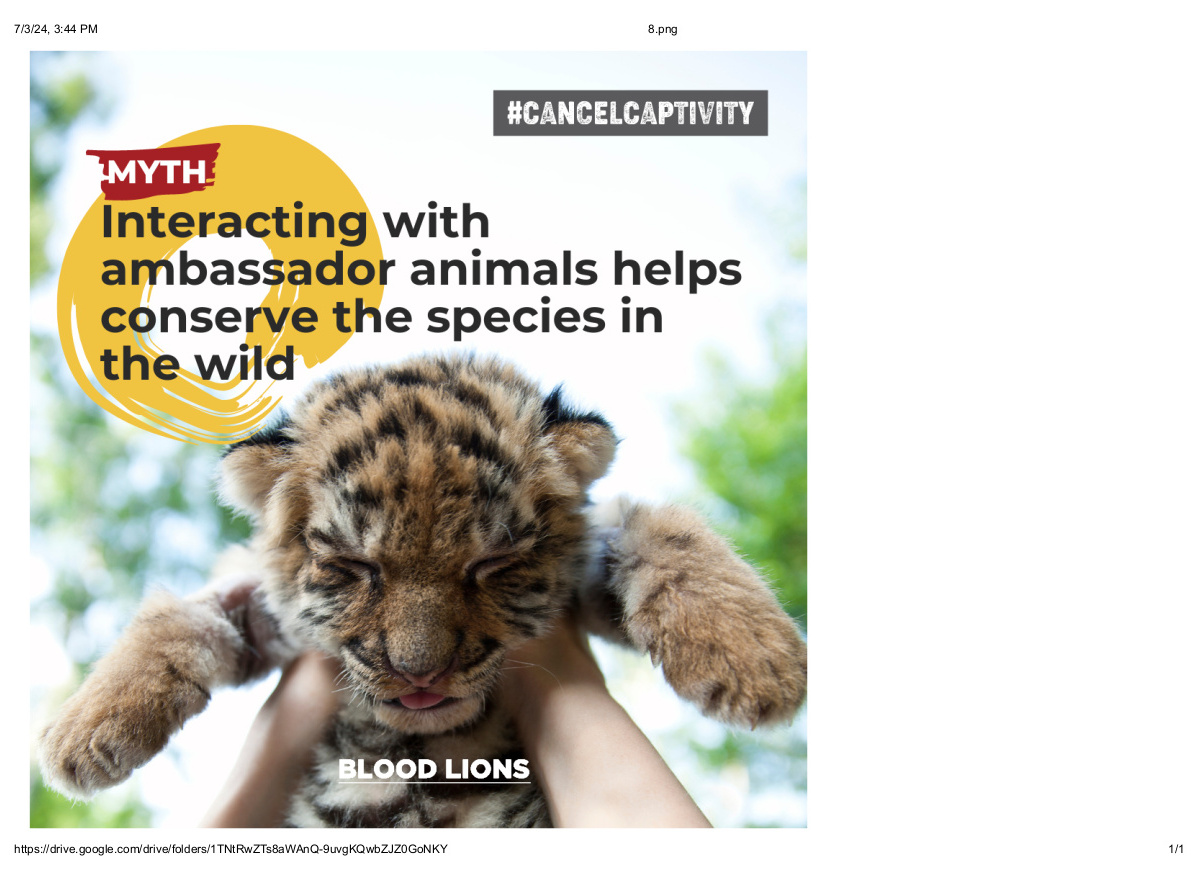
MYTH: Interacting with ‘ambassador animals’ helps conserve the species in the wild
Education should never take preference over the welfare of an animal. There is no doubt that raising awareness around species conservation issues and educating the public on these topics is hugely important. However, this should NEVER be done to the detriment of the well-being of individual animals through intense “pay and play” programmes with ambassador animals. The world is changing, and we need to be more innovative in our educational and awareness raising techniques. Don’t be part of the problem #CancelCaptivity
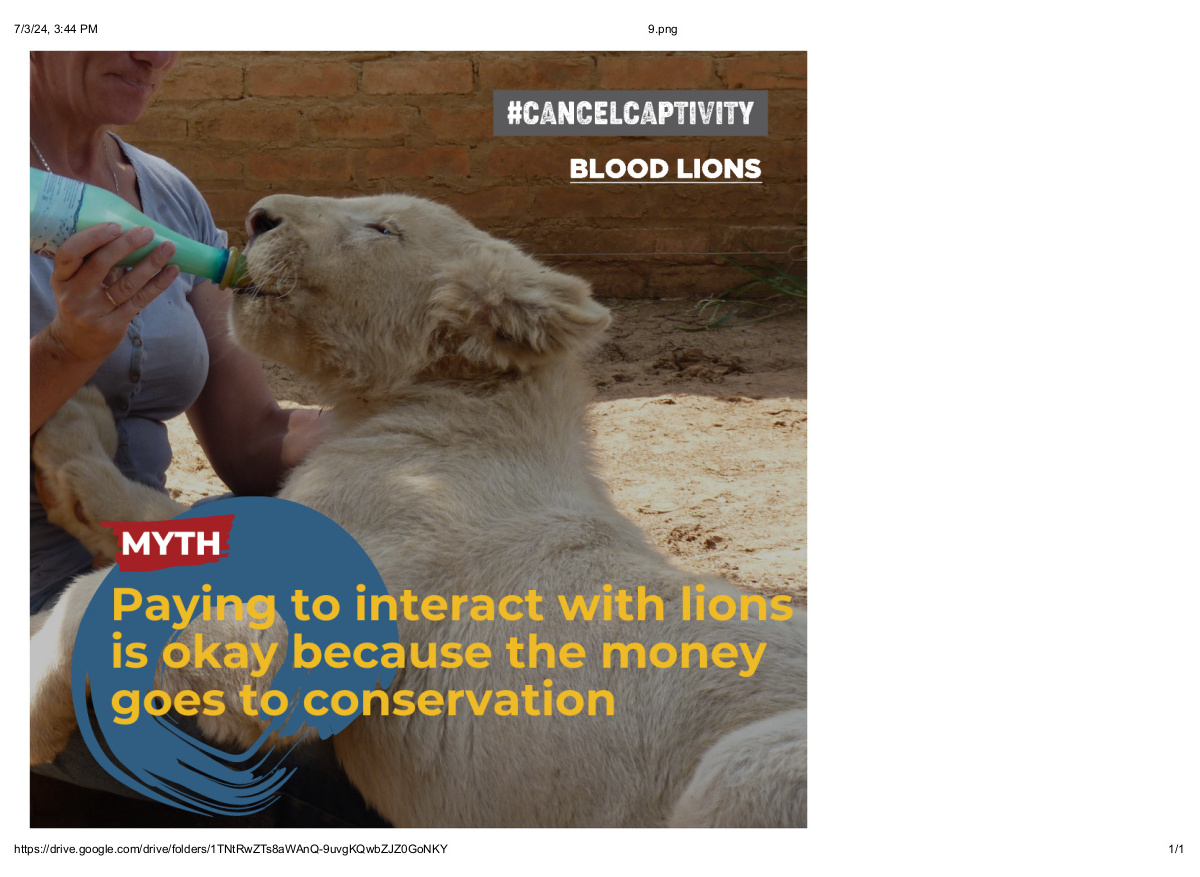
MYTH: Paying to interact with lions is acceptable as the money goes to conservation
There is no evidence that money raised through interactive captive wildlife activities is donated to the conservation of the species in the wild. Furthermore, not one credible conservation organisation would

Life Cycle
Lions born into the commercial captive lifecycle endure exploitation at every stage of life, starting in tourism and ending in a life of captivity, captive hunts, or the bone trade.
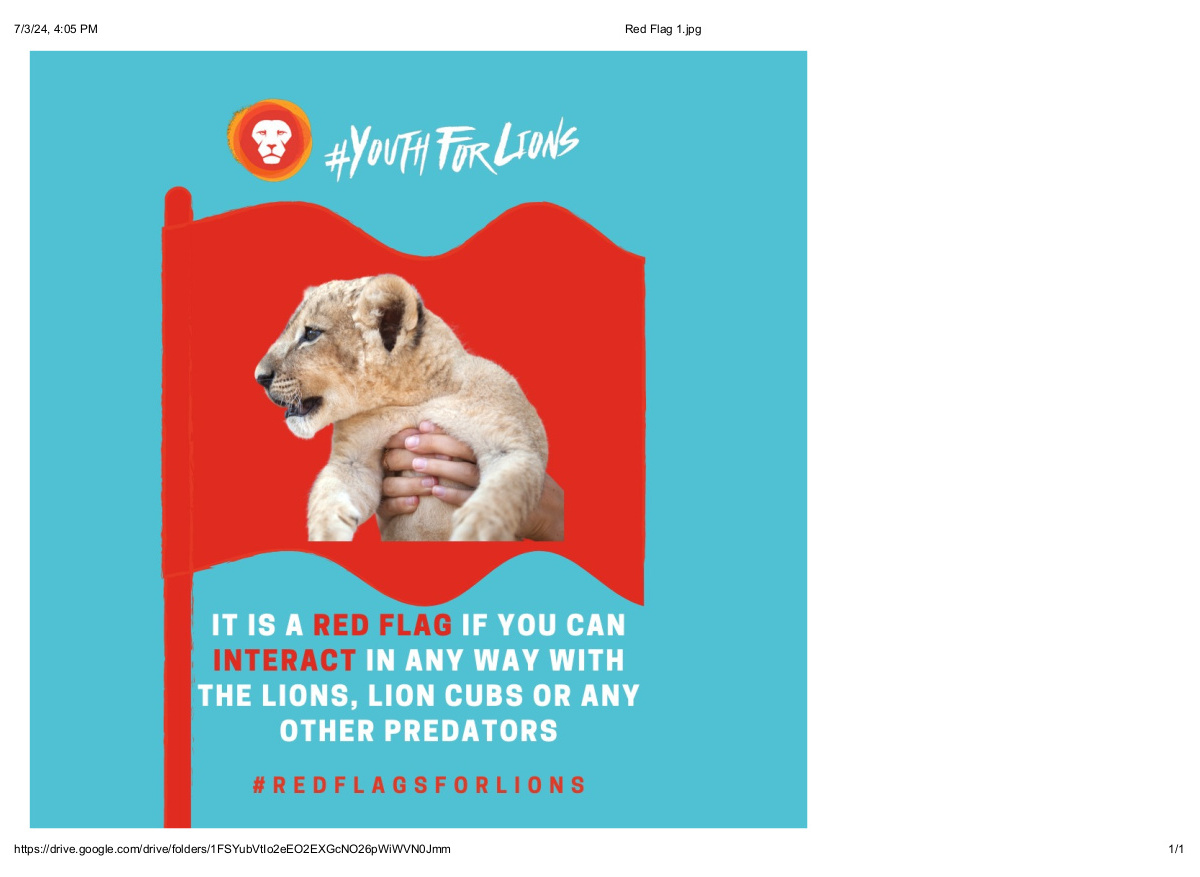
It is a Red Flag if you can interact in any way with the lions,
It is definitely a Red Flag if you can interact in any way with the lions, lion cubs or any other predators held in captivity at a tourism facility. Cubs that are hand-raised and petted by tourists are taken away from their mothers when they are very young. They are often passed off as ‘orphans’ or ‘rejected cubs’ and used for cub petting and bottle-feeding attractions. Questions you need to ask: -Why do you allow interactions with your animals? -Why are these cubs not with their lion mothers?
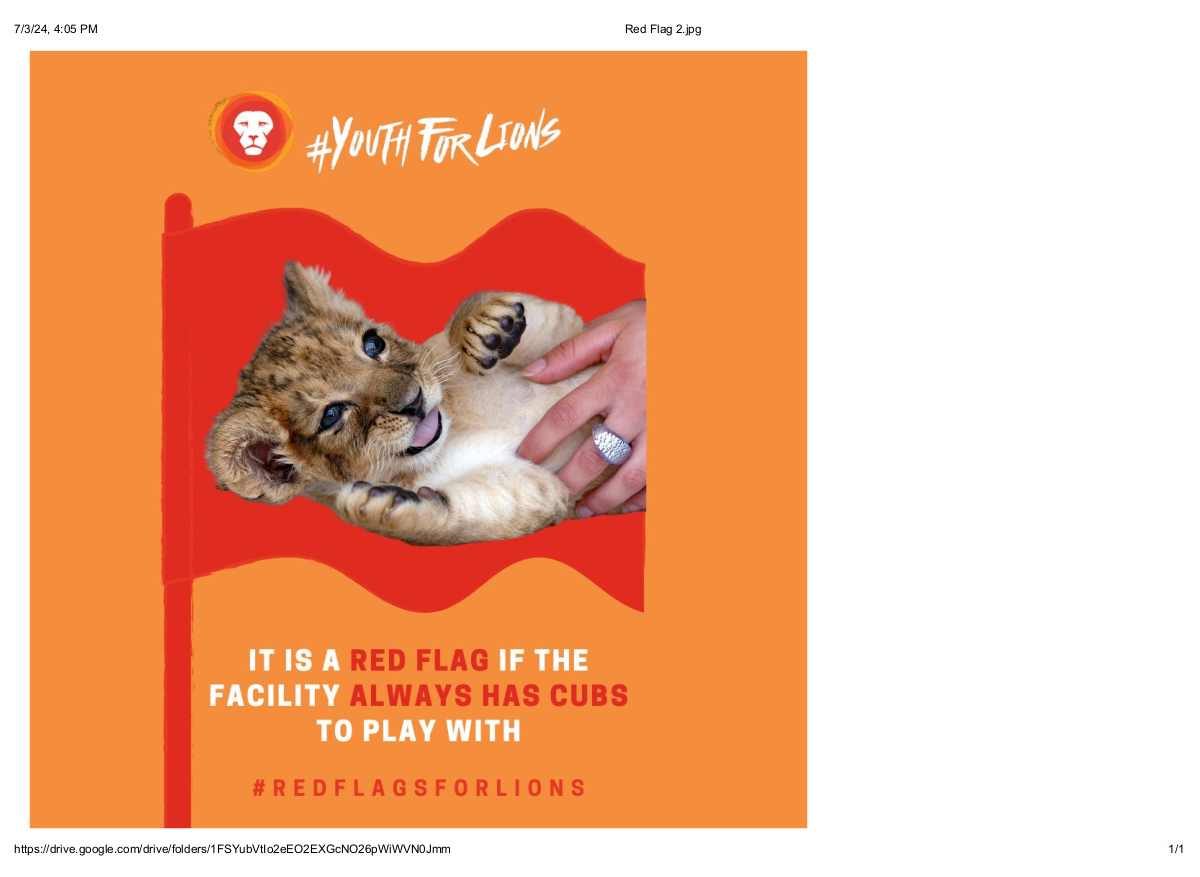
It is a Red Flag if a tourism facility always has lion cubs and other baby predators to play with.
It is a Red Flag if a tourism facility always has lion cubs and other baby predators to play with. A constant supply of cubs means that the facility is either breeding the animals themselves, or they are buying cubs from other facilities that breed them. Scientists agree that breeding predators in captivity and using them as tourist attractions is NOT conservation. Questions you need to ask: -Why do you breed your animals? -What will happen to the cubs when they grow older?
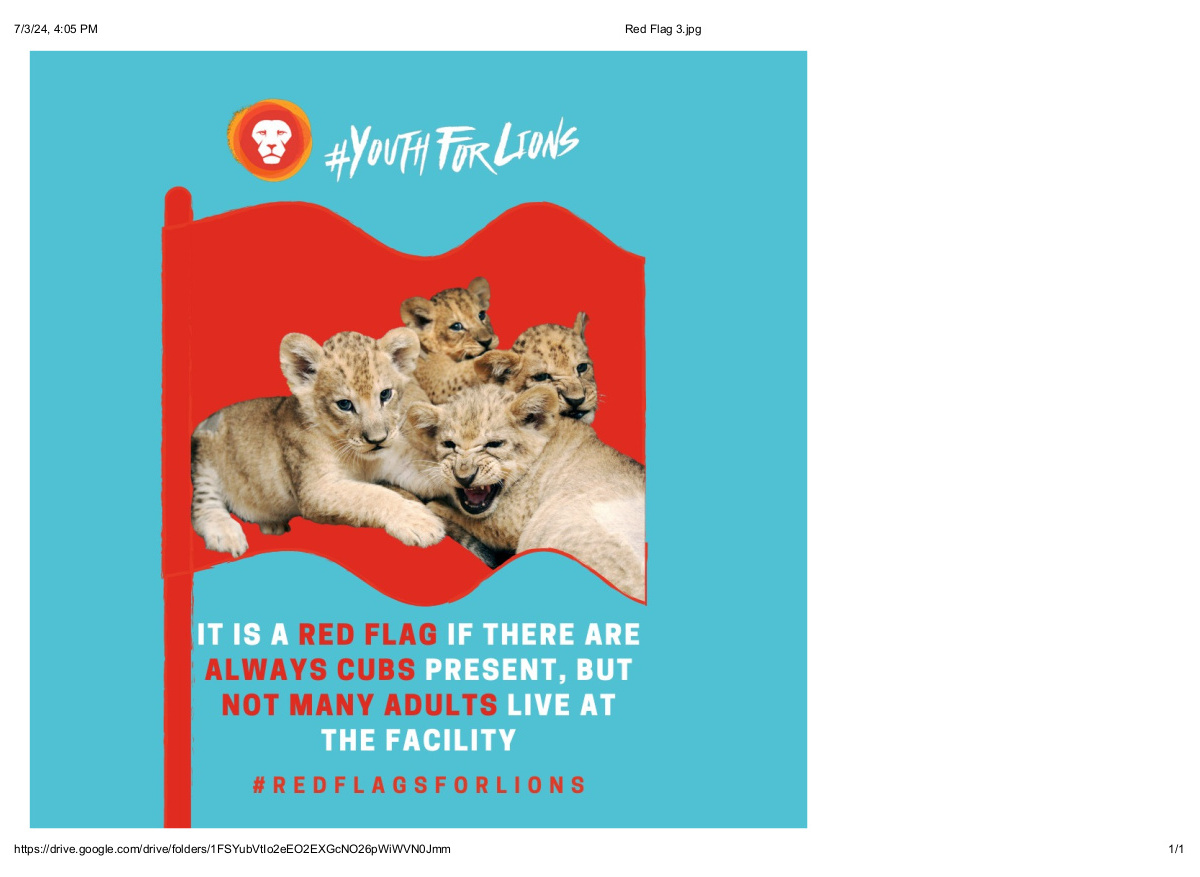
It is considered a Red Flag if there are always baby predators
It is considered a Red Flag if there are always baby predators, but not many adults that live at a captive wildlife facility. If a facility does not give their adult lions, tigers, cheetahs and other predators a home for life, and if they are unclear on where their adult predators go, it is HIGHLY LIKELY that they sell the animals on to other facilities that will use them for breeding, or they could be involved in canned hunting or the bone trade. Not having any adult lions also means that there is no normal social structure for the animals at the facility. In the wild, young lions grow up amongst other cubs, sub-adults and adult lions all living, hunting and playing together as they grow older. A true sanctuary rescues animals and gives them a home for life.
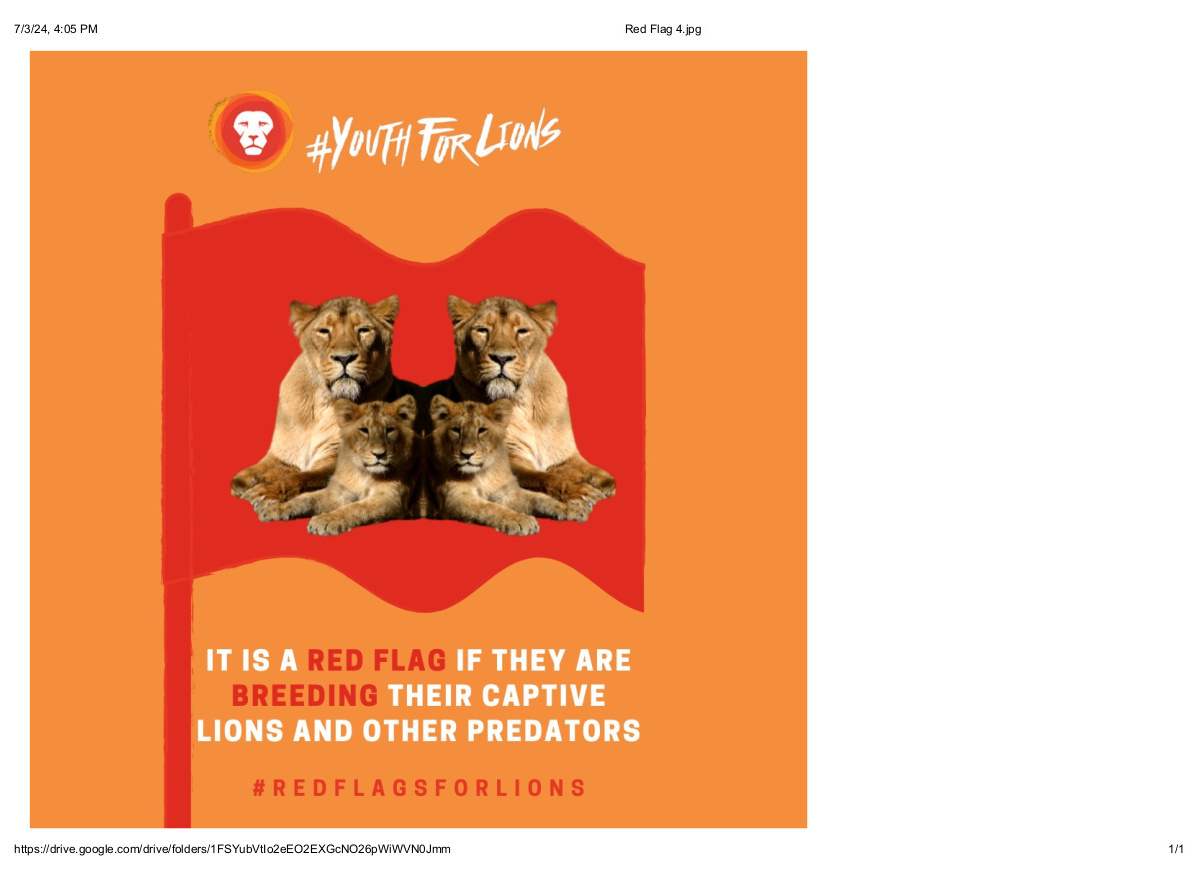
It is considered a Red Flag if a captive wildlife facility is breeding their lions and other predators.
It is considered a Red Flag if a captive wildlife facility is breeding their lions and other predators. Despite what you’re told, captive bred and hand-reared lions can not be released into the wild for a variety of reasons. Captive-bred lions are tame, they cannot hunt for or protect themselves, their genetics are too weak and there is no more safe land left for wild lions in South Africa. Questions you need to ask: -Do you let the animals live here for the rest of their lives? -Do you have more information about your animals that were released into the wild?
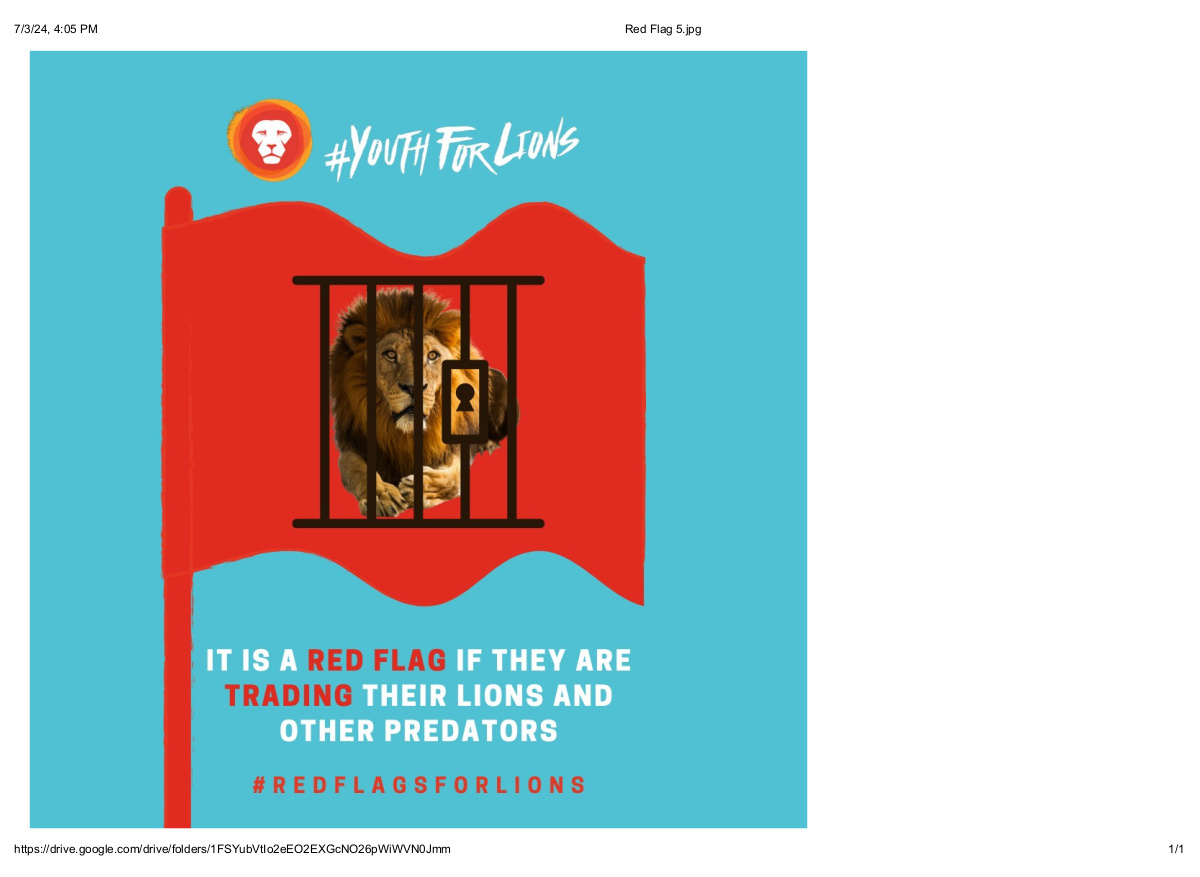
It is a Red Flag if a captive wildlife tourism facility is trading (buying and/or selling) their lions and other predators.
It is a Red Flag if a captive wildlife tourism facility is trading (buying and/or selling) their lions and other predators. If a captive wildlife facility is buying and/or selling their lions and other predators, they are contributing to the cycle of exploitation from cub petting and zoos to canned hunting and the bone trade. They are earning money off of the animals by selling them. Predators are also sold to zoos and breeders overseas where they are often used for tourist interactions. Questions you need to ask: -Why don’t you offer these animals a home for life? -Do you research the places that you are selling to?

